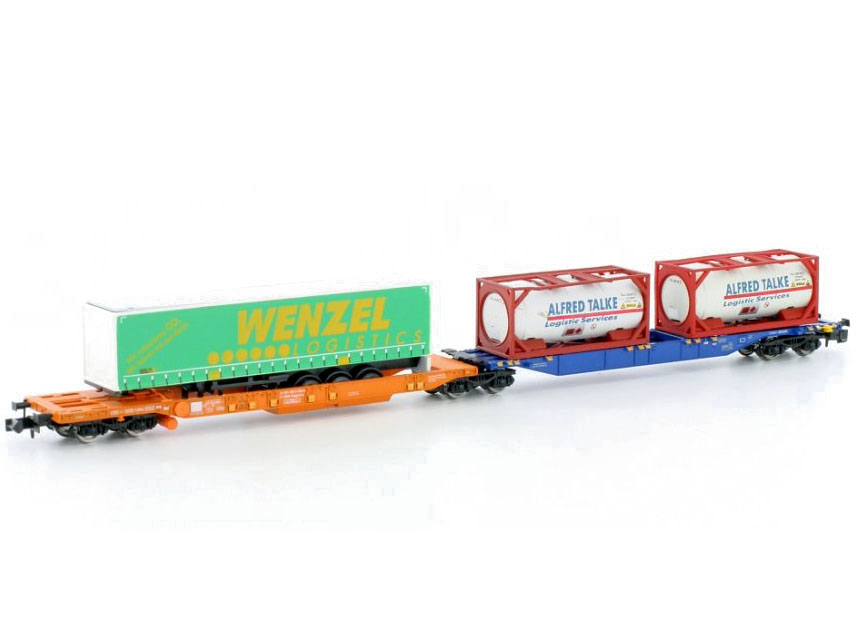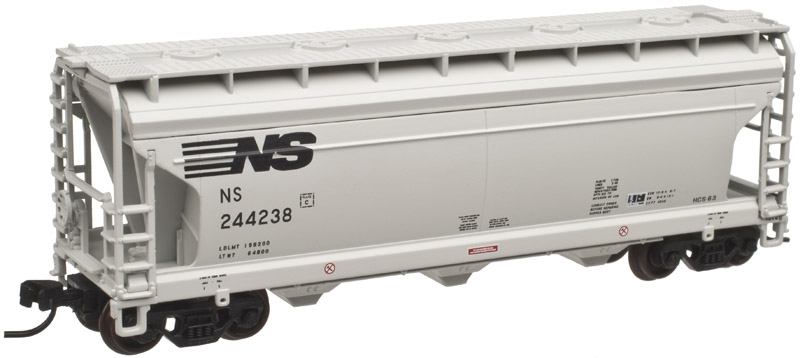Specific Item Information: Container Wagons Sdggmrs744 ÖBB truck Wenzel
Prototype History: The DB ordered from 1998 over 200 container wagons Sgkkms 689. The wagons were purchased specifically for the transport of over 3m high jumbo swap bodies. The loading area has therefore been lowered to allow transport of the containers in international traffic. The cars are in operation with one or two swap bodies, one or two 20-foot containers or a single 40-foot Loaded container.
As per UIC classification, Sgkkms stands for:
S: Special flat wagon with bogies
g: For containers up to 60 feet
kk: Maximum load on class C route: 50 t ≤ m < 60 t
m: Loading length: 15 m ≤ l < 18 m
s: Permitted in trains up to 100 km/h
As per UIC classification, Sgkkms stands for:
S: Special flat wagon with bogies
g: For containers up to 60 feet
kk: Maximum load on class C route: 50 t ≤ m < 60 t
m: Loading length: 15 m ≤ l < 18 m
s: Permitted in trains up to 100 km/h
Road Name History:  The Austrian Federal Railways (German: Österreichische Bundesbahnen or ÖBB, formerly the Bundesbahn Österreich or BBÖ) is the national railway system of Austria, and the administrator of Liechtenstein's railways. The ÖBB group is owned entirely by the Republic of Austria and is divided into several separate businesses that manage the infrastructure and operate passenger and freight services.
The Austrian Federal Railways (German: Österreichische Bundesbahnen or ÖBB, formerly the Bundesbahn Österreich or BBÖ) is the national railway system of Austria, and the administrator of Liechtenstein's railways. The ÖBB group is owned entirely by the Republic of Austria and is divided into several separate businesses that manage the infrastructure and operate passenger and freight services.
The Austrian Federal Railways has had two discrete periods of existence. It was first formed in 1923, using the Bundesbahn Österreich name, as a successor to the Imperial Royal Austrian State Railways (kkStB), but was incorporated into the Deutsche Reichsbahn during the 1938-1945 Anschluss. It was reformed in 1947, using the slightly different Österreichische Bundesbahnen name, and remains in existence in this form.
Major changes currently being made to the Austrian railway network are the construction of the Wien Hauptbahnhof (Vienna main station), the Koralm Railway, the Semmering Base Tunnel and the Brenner Base Tunnel connection with Italy.
From Wikipedia

The Austrian Federal Railways has had two discrete periods of existence. It was first formed in 1923, using the Bundesbahn Österreich name, as a successor to the Imperial Royal Austrian State Railways (kkStB), but was incorporated into the Deutsche Reichsbahn during the 1938-1945 Anschluss. It was reformed in 1947, using the slightly different Österreichische Bundesbahnen name, and remains in existence in this form.
Major changes currently being made to the Austrian railway network are the construction of the Wien Hauptbahnhof (Vienna main station), the Koralm Railway, the Semmering Base Tunnel and the Brenner Base Tunnel connection with Italy.
From Wikipedia
Item created by: Powderman on 2018-08-26 13:43:52. Last edited by CNW400 on 2020-09-09 23:26:05
If you see errors or missing data in this entry, please feel free to log in and edit it. Anyone with a Gmail account can log in instantly.
If you see errors or missing data in this entry, please feel free to log in and edit it. Anyone with a Gmail account can log in instantly.










